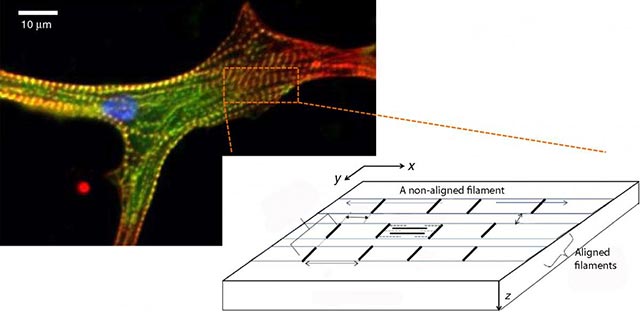Heartbeat Is Complex, Synchronized Event, Find Weizmann Institute and Penn Scientists

Weizmann Institute of Science A chicken heart-muscle cell under a fluorescent microscope; the filaments consist of repeated subunits (bright dotted lines). The schematic representation shows three neighboring filaments; the black lines are the boundaries of their subunits, such that the lower filament is aligned with the middle one, while the upper one is not.
The findings, reported recently in Nature Communications, provide an extremely detailed glimpse into the mechanisms behind normal and irregular heart muscle cell contractions. The study may help define the limitations of existing therapies for abnormal heartbeat and, in the future, suggest ways of designing new ones.
Each heart muscle cell consists of numerous parallel filaments comprising repeated subunits. When the heart beats, each individual filament contracts to produce muscle cell contractions.
Optimally, all the filaments should contract in a synchronized manner, thus ensuring the greatest amplitude of contraction for each muscle cell and ultimately, the strongest and most effective beating of the entire heart. However, a new theoretical model proposed and analyzed by Prof. Samuel Safran and postdoctoral fellow Dr. Kinjal Dasbiswas of the Weizmann Institute’s Department of Materials and Interfaces suggests that the filaments contract together only when their subunits, and subunit boundaries, are aligned with one another.
Since such alignment usually only happens among a limited number of neighboring filaments, these contract together as a bundle — however, each such bundle contracts out of phase with others. Therefore, a heart cell does not necessarily beat as a single uniform entity; rather, the number of different beating entities in the cell depends on the bundle number, which may reach more than two dozen.
The theory, which uses the methods of statistical physics, further predicted that the alignment of the filaments in the heart muscle cell depends on the cell’s physical environment, and more specifically on the elasticity of the supporting structure (called the extracellular matrix). The alignment is best when this structure is not too soft and not too rigid. The prediction took into consideration various forces operating on the microscale, particularly mechanical forces that are exerted on each filament subunit by neighboring filaments via the extracellular matrix.
By assuming that only structurally aligned filaments beat together, the Weizmann theorists were able to quantitatively explain experimental findings by their collaborators from the University of Pennsylvania (aka Penn), Prof. Dennis Discher and Dr. Stephanie Majkut. In the experiments, the Penn scientists had placed embryonic heart cells from chicks on support surfaces of varying stiffness, and found that two strikingly different properties – the structural alignment of the filaments and the beating strength of the cell – depended on the rigidity of the supporting surface.
By providing a theoretical basis for these experiments, the Weizmann model may help explain how filaments become aligned in heart muscle cells during embryonic development, and how their arrangement correlates with the muscle function in the adult heart.
This correlation suggests that the current means of treating irregular heartbeat may be limited to a certain extent by the structural order of heart muscle filaments – however, the new understanding may one day help design improved treatments for heart disease. For example, in the future, if new heart cells are grown to replace diseased ones, their growth environment may be manipulated so that their structure is well ordered and, to paraphrase Keats, all their filaments beat as one.
Prof. Samuel Safran’s research is supported by the Gerhardt M.J. Schmidt Minerva Center on Supramolecular Architectures, which he heads; the US-Israel Binational Science Foundation; the Israel Science Foundation; Antonio and Noga Villalon, Winnetka, IL; the Clore Center for Biological Physics; the Kimmelman Center for Structural Biology; and the Kimmel Stem Cell Research Institute. Prof. Safran is the incumbent of the Fern and Manfred Steinfeld Professorial Chair.
Dr. Kinjal Dasbiswas’s research is supported by a fellowship from the Council of Higher Education.
Contact Information
Jennifer Manning
Director, Science Content
jennifer@acwis.org
Phone: 212-895-7952
Media Contact
All latest news from the category: Health and Medicine
This subject area encompasses research and studies in the field of human medicine.
Among the wide-ranging list of topics covered here are anesthesiology, anatomy, surgery, human genetics, hygiene and environmental medicine, internal medicine, neurology, pharmacology, physiology, urology and dental medicine.
Newest articles

NASA: Mystery of life’s handedness deepens
The mystery of why life uses molecules with specific orientations has deepened with a NASA-funded discovery that RNA — a key molecule thought to have potentially held the instructions for…

What are the effects of historic lithium mining on water quality?
Study reveals low levels of common contaminants but high levels of other elements in waters associated with an abandoned lithium mine. Lithium ore and mining waste from a historic lithium…

Quantum-inspired design boosts efficiency of heat-to-electricity conversion
Rice engineers take unconventional route to improving thermophotovoltaic systems. Researchers at Rice University have found a new way to improve a key element of thermophotovoltaic (TPV) systems, which convert heat…



